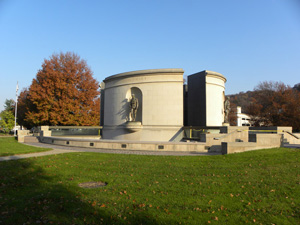

Remember...
Virgil E. Groves
1916-1943
"This war is a new kind of war. It is warfare in terms of every continent, every island, every sea, every air lane in the world."
Franklin Delano Roosevelt
 |
Remember...Virgil E. Groves
|
Virgil Groves was born in Deepwell, West Virginia, on February 16, 1916, to Mary Ella Tyree Groves and Richard D. Groves. Deepwell was in Nicholas County, near Canvas, and was a known place 1911-1935 (West Virginia Division of Culture and History historical maps). The record of Virgil's birth gives his place of birth in Deepwell, but by the time he was registered for military service, the location was given as Canvas.
In the 1920 Federal Census, the Groves family was found in Nicholas County with children Nita, Verner, Vada, Virgil, and Heber. Mr. Groves was a farmer on land that they owned. The children ranged in age from one year and four months to ten years. Virgil was nearly five at the time the record was made.
In 1930, the family was joined by another son, John, and another daughter, Virginia, ages nine and six, in Nicholas County. Mr. Groves was still farming, and daughter, Nita, 20 years old, was teaching. Son Vernon was listed as a laborer in the farming industry. Virgil was 14 and in school.
On October 16, 1940, Virgil Groves registered for military service. According to his draft card, he was living in Spring Hill, West Virginia (located in South Charleston), and working for Maytag. He listed his sister, Nita Bell, who had married Okey Bell in 1930, as his next of kin. She also was living in Spring Hill.
Virgil Groves was enlisted in the U.S. Army on June 11, 1941 in Huntington. His enlistment record shows that he was a salesman and had four years of a high school education. The next public record available for Virgil Groves was found among 1942 marriage certificates. Virgil Groves was married to Katherine Conley at the Jordan Chapel parsonage on Groves Road in Canvas on August 24, 1942, by George Ford. He was 26. Miss Conley, from McDowell County, was by then living in Nicholas County and was 21.
By February 1943, Virgil had been in the army for several months and was living in Colorado. Stationed at Camp Carson, he had attained the rank of sergeant in the quartermaster detachment. His brothers, John and Heber, were also in the army. John was also stationed in Colorado, and Heber was in Texas.
According to Fort Carson website,
Camp Carson was established in 1942, following Japan's attack on Pearl Harbor. The city of Colorado Springs, Colorado purchased land south of the city and donated it to the War Department. Construction began immediately and the first building, the camp headquarters, was completed January 31, 1942. Camp Carson was named in honor of the legendary Army scout, General Christopher "Kit" Carson, who explored much of the West in the 1800s.At the construction's peak, nearly 11,500 workers were employed on various construction projects at the new camp. Facilities were provided for 35,173 enlisted men, 1,818 officers and 592 nurses. Nearly all of the buildings were of mobilization type construction, with wood sided exteriors. The hospital complex was constructed of concrete block, and considered to be semi-permanent, and had space for 1,726 beds, expandable to 2,000 beds. The 89th Infantry Division was the first major unit to be activated at Camp Carson. During World War II, over 100,000 soldiers trained at Camp Carson. Along with three other infantry divisions:the 71st Infantry Division, 104th Infantry Division and 10th Mountain Division:more than 125 units were activated at Camp Carson and more than 100 others were transferred to the Mountain post from other installations. ("Fort Carson: History," accessed 1 December 2017, http://www.carson.army.mil/DES/pmo/history.html.)
Sgt. Groves was a member of the quartermaster detachment. No record could be found that describes the specific area in which he was working. Quartermasters supplied troops with food, clothing, and equipment. They ensured the supply of fuel. They also performed the tasks of graves registration and cared for the remains of the dead. (William F. Ross and Charles F. Romanus, The Quartermaster Corps: Operations in the War against Germany [United States Army in World War II: The Technical Services (Washington, DC: U. S. Army Center of Military History, 1991)], accessed 1 December 2017, http://www.history.army.mil/html/books/010/10-15/CMH_Pub_10-15.pdf.)
On January 27, 1943, Sgt. Groves died, the victim of an auto accident. The Greeley Daily Tribune in Greeley, Colorado, described the accident:
Colorado Springs, Jan. 28 - Sgt Virgil Groves, stationed at Camp Carson with the quartermaster corps, died Wednesday night of injuries received several hours earlier when he was struck by one of two automobiles involved in a collision at a street intersection ("Sergt. Virgil Groves Dies from Injuries," January 29, 1943, accessed 1 December 2017, https://www.newspapers.com/image/27262586/?terms=virgil%2Bgroves.)
The Nicholas Chronicle on February 2, 1943, "Sgt. Virgil Groves Died from Auto Accident," reported the news, stating that he "died a few hours after he was struck by an automobile as he was walking on the highway en route to his home from the camp." Similarly, the accident was reported in the Charleston Gazette, Friday, January 29, 1943, "Nicholas Co. Soldier Killed in Car Wreck," noting that the news was received by Mrs. O. H. Bell of Spring Hill.
Article prepared by Cynthia Mullens
August 2017

West Virginia Archives and History welcomes any additional information that can be provided about these veterans, including photographs, family names, letters and other relevant personal history.